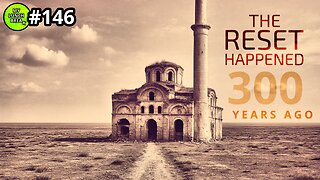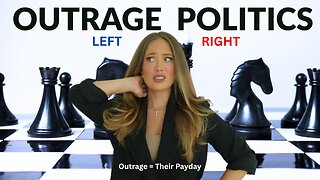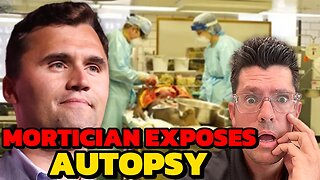Premium Only Content

Episode 3221: From Lenin to Vatican II: A Spirit of Revolution in the Church
Nightly Zoom Coordinates for Rosary:
Meeting ID: 865 8978 0399
Passcode: Wjjv4960!
Speak Lord for your Servant is Listening
Book Recommendation of the Day
Liberation Theology: How Marxism Infiltrated the Catholic Church Julio Loredo de Izcue A critique of Liberation Theology, arguing that Marxist ideas have made inroads into this theological movement and the Church.
AA-1025: Memoirs of the Communist Infiltration into the Church Marie Carre Purports to be notes / memoirs showing how a communist intentionally entered priesthood to subvert the Church from within (semina sedition). Gives a more personal, narrative perspective.
Introduction
I’m going to do a slight pause on the Patristic Fathers writing and how they need to influence your life. Mostly because Catholics today have become students of nothing and no one. The modern Catholic is more concerned with happy happy and not to serious of a faith or really anything. Kind of like a child that covers its ears not to hear the truth. You may say “Okay Walt what are you going to rant about today”.
Throughout the twentieth century, powerful forces in media, politics, and even within the Church worked tirelessly to shape public perception. Instead of exposing the true dangers of communism, they often chose to mute or ridicule the voices that warned against it. In America, Senator Joseph McCarthy was painted as a paranoid lunatic rather than a man raising real concerns about communist infiltration in government and culture. In the Church, prophetic figures such as Bishop Fulton Sheen and later Archbishop Marcel Lefebvre were branded as alarmists for speaking plainly about the growing revolution within the Church itself a revolution that echoed the same Marxist spirit tearing through nations.
At the same time, Our Blessed Mother warned at Fatima that communism would spread its errors throughout the world if mankind did not repent and return to God. Yet this heavenly warning, perhaps the clearest spiritual diagnosis of the age, has been sidelined, downplayed, or reinterpreted to fit the very modernist narrative that enabled communism’s spread.
The pattern is unmistakable: rather than allow the faithful or the public to see the full truth, certain powers preferred to control the narrative. By silencing prophets, ridiculing defenders of the Faith, and downplaying divine warnings, they paved the way for a culture in which revolution both political and spiritual could advance unchecked.
So folks we are really at a crossroads. The blinders must come off and we need to see the reality before us. The rot of our Church, the faithful and the culture are crying out for vengence from God.
I want to speak to you about something that most people have not been educated on and that is how Vladimir Lenin unleashed the most significant autrocity on mankind and how his effects have fully manifested themselves today.
From Lenin to Vatican II: A Spirit of Revolution in the Church
Segment 1: Lenin’s Blueprint for Revolution
In 1902, Vladimir Lenin published What Is to Be Done? He argued that workers would never spontaneously rise to socialism. Left alone, they would only seek higher wages and shorter hours “trade-union consciousness.” A revolutionary elite had to manufacture consciousness from the outside. No this was 16 years before the Russian revolution.
Key Quotes from Lenin
• “The history of all countries shows that the working class, exclusively by its own effort, is able to develop only trade-union consciousness.”
• “Socialist consciousness is something introduced into the proletarian class struggle from without.”
Lenin was blunt about how revolution is not a gentle process but must be carried out with force, coercion, and confrontation. In What Is to Be Done? (1902), he does not literally use the phrase “beat them over the head,” but his language is militant and uncompromising. He explicitly rejects the idea of passively educating or “patting” the workers into consciousness. Instead, he calls for an organized, disciplined vanguard that would impose ideology and, when necessary, use harsh struggle to achieve results.
Here are some relevant passages and their meaning:
1. Change cannot come softly — it must be imposed
“Without revolutionary theory there can be no revolutionary movement. This thought cannot be insisted upon too strongly at a time when the fashionable preaching of opportunism goes hand in hand with an infatuation for the narrowest forms of practical activity.”
(What Is to Be Done?, Ch. 1)
Lenin here is saying: it’s not enough to guide people slowly or kindly (“patting on the head”); revolution requires theory to be imposed from above, not grown gently from below.
2. Forceful struggle is necessary, not mere persuasion
“The working class, exclusively by its own effort, is able to develop only trade-union consciousness… The theory of socialism grew out of the philosophic, historical, and economic theories elaborated by educated representatives of the propertied classes.”
(What Is to Be Done?, Ch. 2)
This means workers on their own will never “get it.” The vanguard must force a new consciousness upon them, even if they resist. It is not a matter of gentle persuasion but of ideological dominance.
3. Revolution requires merciless struggle
“The history of all countries shows that the working class, exclusively by its own effort, is able to develop only trade-union consciousness… The task of Social-Democracy is to combat spontaneity, to divert the working-class movement from this spontaneous trade-unionism… and to bring it under the wing of revolutionary Social-Democracy.”
(What Is to Be Done?, Ch. 2)
Lenin insists that you must fight against what comes naturally (“spontaneity”). In other words: don’t let people be content. You must push, confront, and even crush natural instincts until they conform to the new ideology.
4. Harshness toward opponents inside the movement
“Without a revolutionary theory there can be no revolutionary movement. This thought cannot be insisted upon too strongly at a time when the fashionable preaching of opportunism goes hand in hand with an infatuation for the narrowest forms of practical activity… The role of vanguard can be fulfilled only by a party that is guided by the most advanced theory.”
(What Is to Be Done?, Ch. 1)
Lenin means that half-measures or compromises are useless. The vanguard must strike hard at any deviation not tolerate or gently correct it.
5. Summary in plain terms
While Lenin doesn’t literally say “beat them over the head,” his message is unmistakable:
• Workers left alone will never rise beyond basic demands.
• Therefore, their instincts must be overruled and redirected by forceful intervention.
• Revolution requires conflict, not comfort.
• Any softness (“patting heads”) produces only compromise so agitation, confrontation, and unyielding pressure are the means.
Catholic Counterpoint
The Church never manufactures truth. Her teaching is not ideological but revealed, “from above” handed down through Tradition and safeguarded by the Magisterium.
St. Augustine
“What they [heretics] held, they held not of the Church, but against the Church.” (On Baptism, Against the Donatists)
Let’s put Lenin’s “by force, not by persuasion” approach side by side with what happened in the Church after Vatican II. While the Council itself was billed as pastoral and non-coercive, the implementation was often anything but. Many Catholics who wanted to remain faithful to Tradition discovered that “gentle aggiornamento” was in practice enforced with harsh suppression, coercion, and bans much like Lenin’s insistence that change could only happen by force.
Here’s a detailed comparison:
Lenin vs. Post-Vatican II: Forceful Imposition of Change
Lenin’s Approach Post-Vatican II Parallel
“Socialist consciousness is something introduced from without… The task of Social-Democracy is to combat spontaneity.” (What Is to Be Done?) Catholics attached to Tradition were told their fidelity was “rigidity.” Instead of being respected, their natural devotion was actively suppressed with the Latin Mass forbidden in most parishes.
Lenin rejected compromise: half-measures or gradual persuasion were “opportunism.” Pope Paul VI in 1976 told Archbishop Lefebvre: “You are not allowed to judge the Church itself. You cannot say, ‘I am with the Church, but not with the Council.’” Dissent from innovation was treated as rebellion, not dialogue.
Lenin demanded a vanguard to seize institutions education, unions, presses and impose ideology. Post-conciliar elites rewrote catechisms, replaced the Baltimore Catechism, and forced CCD programs filled with vague slogans. Priests who resisted were reassigned or silenced. Whole seminaries were purged of “rigid” formation.
Lenin dismissed workers’ instincts as backward they had to be “re-educated” under strict discipline. Paul VI’s Ministeria Quaedam (1972) abolished minor orders and the subdiaconate, severing seminarians from centuries of tradition. Habits were discarded for nuns. Convent life was dismantled to “re-educate” religious into modern roles.
Lenin called for agitation and sharp polemic to break resistance, not gentle persuasion. The Congregation for Divine Worship under Bugnini imposed the Novus Ordo universally. Priests who refused risked suspension. The faithful were told, “The old Mass is forbidden” a direct, harsh rupture with what nourished saints for centuries.
Lenin saw opponents inside the socialist movement as dangerous and insisted they be crushed. Traditionalist groups like the Catholic Traditionalist Movement (Fr. Gommar DePauw) were ostracized. Even the Dominicans of Avrillé were marginalized. Lefebvre’s followers were threatened with excommunication.
Examples of Coercion in the Post-Vatican II Church
1. Suppression of the Latin Mass
o After 1970, bishops worldwide banned the Traditional Latin Mass. Faithful priests were forced to use the Novus Ordo under obedience, regardless of conscience. Many elderly Catholics were bewildered, told overnight that the Mass they grew up with was “obsolete.”
o Pope Paul VI: “The Latin language is itself a great and noble part of the heritage of the Church, but we are giving up its use” (General Audience, Nov. 1969). The “giving up” was not optional — it was enforced.
2. Religious Life “Reformed” by Force
o Tens of thousands of nuns left religious life in the 1970s when their habits were stripped, communities dissolved, and traditional rules abolished. This was not an organic change but a mandated upheaval.
3. Silencing of Theological Opposition
o Priests who resisted modernist catechesis or liturgy were reassigned, forbidden from teaching, or even excommunicated (e.g., Archbishop Lefebvre in 1988).
o Traditionalist publishing was censored by diocesan authorities, much like Lenin’s control of presses.
4. Catechetical Re-engineering
o Just as Lenin dismissed natural worker instincts, post-Vatican II reformers dismissed the instincts of the faithful to cling to devotions (rosary, confession, Marian consecration). These were mocked as “pre-conciliar” or “superstitious.”
The Deeper Parallel
• Lenin: revolution required confrontation, suppression of instinct, capture of institutions, and forced re-education.
• Post-Vatican II Church: reforms were not optional; they were mandated, enforced, and imposed, often by silencing, suppression, and stripping away Tradition.
What both share:
• Distrust of the faithful to remain true to Tradition/instincts.
• Belief in an elite vanguard to impose a new order.
• Use of coercion, not persuasion, to bring about transformation.
Segment 2: The Post–Vatican II Prelates
The Council’s Aim
Pope John XXIII announced Vatican II as a pastoral council to “open the windows” of the Church. But after 1965, a new self-appointed vanguard of bishops, theologians, and liturgists seized the post-conciliar moment to impose sweeping changes.
Examples
• The New Mass (1969): Bugnini’s Consilium replaced organic liturgical development with fabrication even inviting six Protestant ministers to advise.
• The Dutch Catechism (1966): Spread heterodox teaching on sin, the Eucharist, and the priesthood; condemned by Rome, yet widely distributed.
• Suppression of Tradition: Fr. Gommar DePauw and communities like Avrillé were marginalized simply for fidelity to the old ways.
Pius X’s Warning
“The partisans of novelty are bent on changing everything … by introducing liturgical novelties, by promoting dangerous doctrines, and by scorning the authority of bishops.” (Pascendi, 1907)
Segment 3: The Parallel Principles
Here’s where the symmetry between Lenin and post-Vatican II reformers becomes unmistakable:
Lenin’s Principle Post-Vatican II Parallel
“Socialist consciousness must be introduced from without.” Vatican II elites imposed a “new consciousness” on the faithful: “People of God,” “subsists in,” “dialogue.”
“We must arouse dissatisfaction with narrow trade-union strivings.” Catholics were told their “rigid” attachment to the Mass of Ages was outdated — they needed aggiornamento.
“The working class, left to itself, cannot go beyond trade-union consciousness.” Ordinary Catholics, left with Tradition, were viewed as incapable of renewal; only experts could “update” the faith.
Lenin seized schools, unions, presses to spread ideology. Reformers captured catechesis, replacing the Baltimore Catechism with vague CCD texts that avoided doctrine.
Lenin distrusted workers’ instincts. Paul VI’s Ministeria Quaedam (1972) suppressed minor orders, severing continuity with clerical formation.
Revolution required a vanguard elite. Post-conciliar change was driven by Bugnini’s Consilium, bishops’ conferences, and “experts.”
Pope Pius XII (Mediator Dei, 1947): “The way one worships is the way one believes.” The innovators knew this truth and used it.
Segment 4: The Fruits of Revolution
For Lenin
The Bolsheviks seized power. But Russia lost its Christian soul, and millions perished in the name of progress.
For the Church
• Mass Attendance: 75% in 1958 → under 25% by 1980 in the U.S.
• Vocations: Priestly ordinations dropped by more than half within 20 years.
• Religious Life: Tens of thousands of nuns abandoned their vows as habits and communal discipline were discarded.
• Doctrinal Confusion: Rising disbelief in the Real Presence and other core truths.
Ancient Warning
Pope Gelasius I: “The Church has no right to innovate … She is only the guardian of what she has received.”
Segment 5: The Traditional Catholic Response
Apostolic Continuity
St. Paul: “For I delivered unto you first of all, which I also received.” (1 Cor. 15:3). Tradition means continuity, not reinvention.
Archbishop Marcel Lefebvre (1905–1991)
Founded the Society of St. Pius X in 1970 to preserve the Mass of Ages and authentic priestly formation. Like Athanasius against Arianism, he stood almost alone against a tide of innovation.
St. Athanasius
“Even if Catholics faithful to Tradition are reduced to a handful, they are the true Church of Jesus Christ.”
Lesson
Revolutions produce committees. Renewal comes through saints.
Segment 6: Concluding Reflection and Prayer
Reflection
Lenin’s vanguard destroyed Russia’s soul. Vatican II elites fractured Catholic life. Yet the Church, unlike empires, cannot be destroyed. Christ’s promise remains: “The gates of hell shall not prevail.” (Matt. 16:18).
The solution is fidelity clinging to what has been handed down, resisting the artificial engineering of “new consciousness.”
Side Notes before reading scripture for today:
1. Survey being conducted:
• https://slu.az1.qualtrics.com/jfe/form/SV_3CYFC9qAsUX6rUa?Q_CHL=qr
Read a fantastic book:
The book Blacklisted by History: The Untold Story of Senator Joe McCarthy and His Fight Against America's Enemies (2007) by journalist M. Stanton Evans is a revisionist history of Senator Joseph McCarthy and the anti-communist investigations of the 1950s.
Main Theme
Evans argues that the conventional image of McCarthy as a reckless demagogue who falsely accused innocent people was largely a product of media distortion and political hostility. Instead, Evans contends that McCarthy’s suspicions about communist infiltration in the U.S. government were, in many cases, substantiated.
Key Points
• Evidence of Infiltration: Drawing from declassified FBI and Venona files, Evans shows that communist agents really had infiltrated parts of the U.S. government during the 1930s–40s.
• Media Narrative: He claims that mainstream journalists and historians created the caricature of “McCarthyism” as hysteria, while ignoring or downplaying verified communist activity.
• Reassessing McCarthy: Evans tries to separate McCarthy’s actual record from the myths, showing where McCarthy was right, where he was sloppy, and how he was undermined by political opponents.
• Cold War Context: The book situates McCarthy in the larger struggle between the U.S. and Soviet Union, emphasizing that fears of subversion were not baseless paranoia.
Why It’s Controversial
The book challenges decades of consensus that McCarthy was a villain, instead portraying him as someone who, while flawed, was pursuing real threats. Critics of the book say it whitewashes McCarthy’s abuses and exaggerates his vindication. Supporters praise it for restoring balance to the historical debate.
Epistle – Galatians 5:25–26; 6:1–10
"If we live in the Spirit, let us also walk in the Spirit. Let us not be made desirous of vainglory, provoking one another, envying one another... Bear ye one another’s burdens, and so you shall fulfill the law of Christ... And in doing good, let us not fail: for in due time we shall reap, not failing. Therefore, while we have time, let us work good to all men, but especially to those who are of the household of the faith."
Reflection on the Epistle
St. Paul exhorts us to live not merely with faith on our lips but with works of love in our lives. To live “in the Spirit” means to walk in humility, avoiding envy, vainglory, and pride. The law of Christ is fulfilled in charity bearing one another’s burdens, forgiving, helping, and serving.
For traditional Catholics, this is a reminder that fidelity to Tradition must never become prideful or contentious. True Tradition is lived charity, rooted in humility. The liturgy, the sacraments, the doctrines of the Church are not ends in themselves, but the wellspring of holiness that enables us to live the law of Christ.
St. Matthew, whom we honor today, shows us this in his own life. Once a publican, despised for his profession, he was called by Christ and left all things behind. His new life was no longer centered on wealth, but on proclaiming the Gospel bearing the burdens of others through his witness.
Gospel – Luke 7:11–16
"And it came to pass afterwards, that He went into a city that is called Naim: and there went with Him His disciples and a great multitude. And when He came nigh to the gate of the city, behold a dead man was carried out, the only son of his mother, and she was a widow... And the Lord seeing her, had compassion on her, and said to her: Weep not. And He came near and touched the bier... And He said: Young man, I say to thee, arise. And he that was dead, sat up, and began to speak. And He gave him to his mother."
Reflection on the Gospel
This moving scene at Naim reveals both the divine power and the human compassion of Our Lord. He confronts the sorrow of a widowed mother, bereft of her only son, and He raises the young man to life. Christ shows that He is Lord over life and death, and that His heart is moved by our suffering.
This miracle foreshadows the resurrection of all the faithful at the end of time, and it points to the sacraments, where Christ gives us spiritual life even now. In Baptism, we are raised from the death of sin. In Confession, the soul once dead is restored. In the Holy Eucharist, we receive the Bread of Life, the pledge of resurrection.
From a traditional Catholic perspective, this Gospel is also a warning: outside of Christ, there is only death. The modern world, rejecting the Cross, marches in the funeral procession of sin. Only Christ can halt that procession and command: “Young man, I say to thee, arise!”
Feast of St. Matthew the Apostle
St. Matthew, once a tax collector, reminds us that no sinner is beyond the reach of Christ’s mercy. At Christ’s call, he left his money table behind and became an Apostle and Evangelist. His Gospel reveals Christ as the fulfillment of the Old Testament, the long-awaited Messiah. His feast teaches us that true discipleship means leaving behind the world to follow Christ in faith and charity.
________________________________________
Application for Today
• Walk in the Spirit: Live your faith with humility and charity, not pride or rivalry.
• Practice charity daily: Bear the burdens of family, friends, and parishioners with patience and love.
• Look to Christ in sorrow: He alone has power over death and brings hope to the hopeless.
• Follow St. Matthew: Be willing to leave behind the comforts and securities of the world to follow Christ more perfectly.
________________________________________
Conclusionary Prayer
O Lord, who didst show Thy compassion at Naim and raise the widow’s son, raise us also from the death of sin to the life of grace. Grant that, living in the Spirit, we may walk in the Spirit, bearing one another’s burdens in charity. Through the prayers of St. Matthew, Apostle and Evangelist, strengthen us to leave all things behind and follow Thee with fidelity, until we too are raised to eternal life.
St. Matthew, pray for us.
Sacred Heart of Jesus, have mercy on us.
Immaculate Heart of Mary, intercede for us.
-
 25:10
25:10
MYLUNCHBREAK CHANNEL PAGE
4 hours agoIstanbul Should NOT Exist - Pt 4
5.71K4 -
 LIVE
LIVE
tminnzy
3 hours agoDROPS ON - BO7 BETA ALL DAY! #BlackOps7
576 watching -
 1:35:48
1:35:48
Jeff Ahern
3 hours ago $8.46 earnedThe Saturday Show with Jeff Ahern
51.5K5 -
 LIVE
LIVE
GritsGG
4 hours agoWarzone Win Grinding! Most Wins in WORLD! 3680+!
139 watching -
 55:45
55:45
Tactical Advisor
4 hours agoNew Product Alert! | Vault Room Live Stream 040
38.4K4 -

Reidboyy
3 hours ago $0.64 earnedTHEY GOT RID OF SBMM WTF!?!? (Go Phillies)
10.1K -
 LIVE
LIVE
The Company Boyz
2 hours agoDying Light: The Beast | Ja Pierdole, Kurwa Bober!
56 watching -
![Mr & Mrs X - Feminism, Family, Federal Reserve, The Rise Of The [DS] Agenda](https://1a-1791.com/video/fwe2/12/s8/1/6/F/R/n/6FRnz.0kob-small-Mr-and-Mrs-X-Feminism-Famil.jpg) 58:10
58:10
X22 Report
11 hours agoMr & Mrs X - Feminism, Family, Federal Reserve, The Rise Of The [DS] Agenda
189K51 -
 16:37
16:37
Robbi On The Record
1 day ago $8.39 earnedThe Theater of Manufactured Outrage - When Left and Right Dance for the Same Puppet Master
44.3K47 -
 31:27
31:27
Stephen Gardner
22 hours ago🔥BOMBSHELL: Mortician EXPOSES Charlie Kirk Autopsy - The Key Evidence EVERYONE Missed!
136K298
